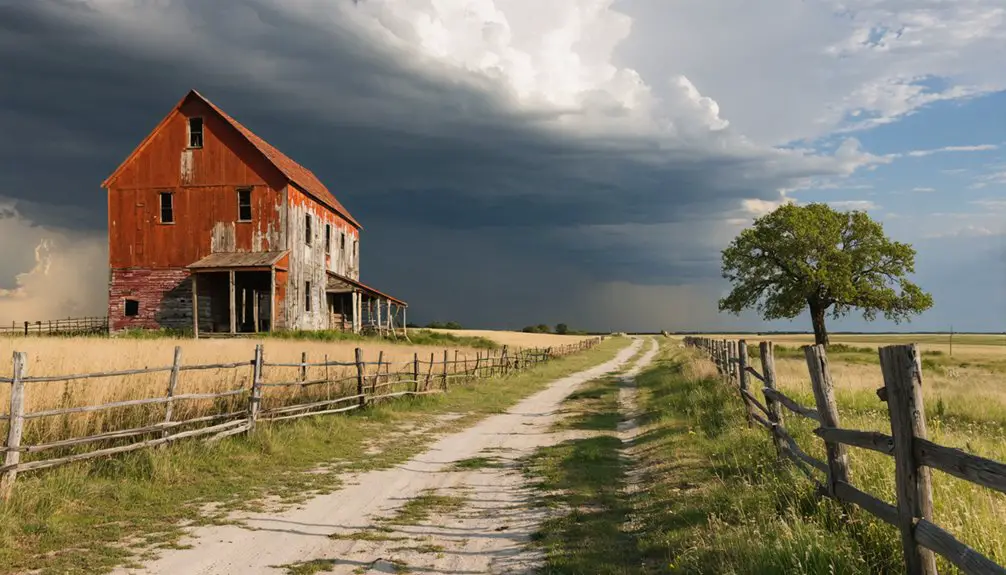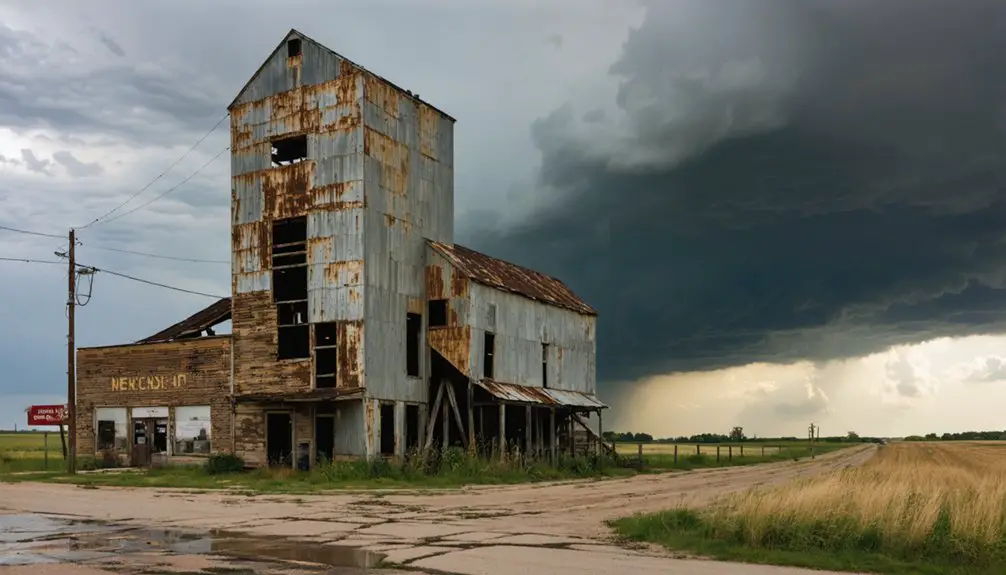You’ll find Hail Ridge nine miles southwest of Mound City in Linn County, Kansas, where it emerged as a prairie settlement in the late 1800s. The community centered around School No. 29 (1875-1957) and the Weatherby family’s general store, with postal services operating from 1879 to 1888. Pioneer families like the Paddocks, Stites, and Stockhoffs built lasting bonds here, though today only the rolling plains and scattered family cemeteries hint at its rich frontier story.
Key Takeaways
- Hail Ridge was a 19th-century prairie settlement in Linn County, Kansas, located nine miles southwest of Mound City.
- The community’s decline began with the loss of its post office in 1888 and lack of railroad access.
- Hail Ridge School (School No. 29) operated from 1875 to 1957, serving as the settlement’s last remaining institution.
- The Weatherby family’s general store served as a trading hub and social center during the town’s active years.
- Today, only historic cemeteries with late 1800s headstones and mixed farmland remain where Hail Ridge once stood.
The Rise of a Prairie Settlement
As frontier settlements dotted the Kansas prairie in the late 19th century, Hail Ridge emerged as a modest but promising community in Linn County, positioned nine miles southwest of Mound City and five miles east of Blue Mound.
Much like settlers at Beersheba, many families faced initial hardships before ultimately abandoning their claims by 1890, yet those who remained helped forge lasting communities.
You’d have found pioneering families like the Paddocks, Stites, Stockhoffs, and Weatherbys facing settlement challenges as they carved out their homesteads in the early 1870s.
Despite the harsh realities of prairie life, pioneer resilience shone through as settlers constructed homes from locally available materials, including distinctive sod houses built from layered prairie soil and grass.
Like the Mennonite settlers who built twenty sod houses using techniques from their homeland, early residents demonstrated remarkable adaptability in their construction methods.
They established essential community infrastructure, including a one-room schoolhouse and post office near the Weatherby’s general store, transforming raw frontier land into a functioning settlement that would serve as a reflection of their determination and grit.
Life at Hail Ridge School
You’ll find evidence of Hail Ridge’s one-room schoolhouse education in School No. 29, where teachers like Hester Elliot and George Ferguson taught multiple grades simultaneously from 1875 to 1957.
The school’s daily routine centered on fundamental subjects like literacy and arithmetic, with students arriving by foot or horseback from within a carefully planned six-square-mile district. The building served as a hub for learning until school operations ceased in 1957.
Teaching resources were basic but practical, reflecting the rural community’s needs and following an agricultural calendar that accommodated planting and harvest seasons. Early photographs from the period, preserved through historical society archives, help document the authentic educational experience at Hail Ridge School.
Daily School Routines
The daily routines at Hail Ridge School revolved around a carefully orchestrated system of multi-grade instruction within its single room. You’d find students from grades one through eight engaged in various school activities simultaneously, with older pupils often helping younger ones master their lessons.
The classroom dynamics shifted throughout the day as children took turns reciting their work aloud, practicing arithmetic at the blackboard, or studying quietly at their wooden desks. Like in Miss M. E. Weatherbie’s first classroom, lessons focused on foundational skills and practical knowledge.
During breaks, you’d join your classmates outside for brief recesses or pitch in with necessary chores. The school day’s rhythm would change with the seasons, as farm families needed their children’s help during planting and harvest.
You’d use simple tools like slates and chalk, making the most of limited resources while learning alongside your rural neighbors.
Teachers and Rural Education
While generations of Hail Ridge students came and went, dedicated teachers like Hester Elliot and George Ferguson shaped young minds in the one-room schoolhouse at Ingram and 600 Road.
You’d find these educators facing unique teacher challenges as they simultaneously taught eight grade levels, adapting lessons for different ages and abilities. Like many early Kansas educators, they often taught in makeshift locations including dugouts, shanties, and converted cellars.
The rural curriculum focused on essential skills – reading, writing, and arithmetic – preparing farm children for their futures.
Teachers didn’t just instruct; they managed everything from maintaining discipline to stoking the stove. They’d adjust schedules around harvest seasons when students might be absent helping their families.
As respected community leaders, they connected isolated farming families across the six-square-mile district until the school’s closure in 1957, marking the end of Hail Ridge’s localized education era.
Commerce and Postal Services
As pioneers settled in Hail Ridge during the late 1870s, commerce established itself around the Weatherby family’s general store, which served as both a trading hub and social center for the growing community.
You’d find the store situated along the southern border of section 30 in Mound City Township, where it stocked essential goods for daily frontier life. The lack of fire departments in frontier towns like Hail Ridge made the wooden structures particularly vulnerable to devastating fires.
The postal impact of having an official U.S. post office from 1879 to 1888 can’t be understated – it connected Hail Ridge to the wider world through mail orders and correspondence.
Like many towns facing lead deposit depletion, the commercial decline in Hail Ridge set in after the post office closed. Without this crucial communication link, business dwindled, reflecting a familiar pattern in Kansas ghost towns where diminishing services and shifting populations led to eventual abandonment.
Notable Families and Community Bonds
Pioneer families who settled in Hail Ridge during the late 1800s formed tight-knit bonds that would define the community for generations.
You’ll find the Weatherbys, Paddocks, Stites, and other founding families created a remarkable family legacy through their shared dedication to farming and local trade. The Weatherby family’s general store became a cornerstone of community life, while families like the Stockhoffs and Strawbridges contributed to the area’s agricultural foundation.
Despite being spread across roughly six square miles per school district, these families demonstrated extraordinary community resilience through mutual support and cooperation. Like many Kansas settlements, the community faced devastating grasshopper invasions that threatened their crops and livelihoods. Much like the residents of Empire City, they experienced rapid population changes as economic conditions shifted.
They’d gather at the one-room schoolhouse, assist each other with farming duties, and maintain strong social connections through the general store and post office, creating an enduring cultural identity that persisted even as the town gradually faded away.
Landmarks and Local Geography

You’ll find Hail Ridge’s most significant landmark at the intersection of Ingram and 600 Road, where the one-room schoolhouse once served as the community’s heart from 1875 to 1957.
The town’s strategic position, nine miles southwest of Mound City and five miles east of Blue Mound, made it an ideal spot for the Weatherby family’s general store and post office that operated from 1879 to 1888.
Today, while the buildings are gone, the landscape tells the story of this lost community through its mixed farmland, historic cemeteries with late 1800s headstones, and the remaining grid of rural roads that once connected residents to neighboring settlements.
Strategic Central Location
While many Kansas ghost towns faded into obscurity, Hail Ridge’s strategic position in Linn County made it a notable hub during its brief existence.
You’ll find this settlement perfectly situated at strategic crossroads, just 9 miles southwest of Mound City and 5 miles east of Blue Mound. The town’s rural accessibility made it an important waypoint for local commerce and communication in the late 1800s.
- A central U.S. post office and Weatherby’s general store served as crucial commercial landmarks from 1879 to 1888
- The one-room schoolhouse at Ingram and 600 Road operated as a community nucleus for 82 years
- A network of rural roads, including 900 Road and Lewis Road, connected residents within a 3-mile radius to important services
Notable Geographic Features
Three distinct geographical features defined Hail Ridge’s rural landscape during its heyday.
First, you’d find gently rolling plains typical of eastern Kansas, punctuated by the elevated landform that gave the settlement its name. The region’s geographic isolation shaped agricultural patterns, with dispersed family farms stretching across the windswept terrain.
Second, you’d notice the natural drainage systems weaving through the countryside, creating a network of small creeks that sustained local farming operations.
Finally, there’s the striking openness of the prairie landscape, largely devoid of natural windbreaks, where strong winds sweep freely across the farmlands.
These features created an environment where settlers adapted to nature’s rhythms, establishing their homesteads along the grid-like rural road system that still exists today.
Lost Structural Sites
Today, little remains of Hail Ridge’s once-vibrant structural landscape, though historical records paint a picture of its nineteenth-century development.
You’ll find the lost landmarks scattered across historical documents, revealing a one-room schoolhouse that served local children from 1875 to 1957, and a post office that operated between 1879 and 1888 near the Weatherby family’s general store.
- The schoolhouse (No. 29) stood at Ingram and 600 Road, serving students within a 6-square-mile radius.
- The Weatherby store marked the town’s southern boundary, functioning as a crucial commercial hub.
- Small family cemeteries remain as the only physical evidence of Hail Ridge’s historical significance.
While modern roads trace the town’s former boundaries, you won’t find any surviving structures from this once-thriving rural community.
The Path to Becoming a Ghost Town

Like many frontier settlements of its era, Hail Ridge’s transformation into a ghost town unfolded through a series of pivotal setbacks between 1875 and 1957.
You’ll find its decline began with the loss of its post office in 1888, a critical blow to the community’s connectivity and official standing. Without railroad access, the settlement couldn’t compete with better-connected towns, leading to gradual community migration as residents sought opportunities elsewhere.
The economic sustainability of local businesses, including the Weatherby general store, suffered as changing transportation patterns drew customers to distant markets.
The political turbulence of Kansas’ early statehood and regional power struggles further strained the community’s stability.
When the schoolhouse finally closed in 1957, it marked the end of Hail Ridge’s last remaining institution.
Frequently Asked Questions
How Did Hail Ridge Get Its Unique Name?
You won’t find the name origin in official records, but local legends suggest intense hailstorms that once pelted the ridge’s settlers gave this Kansas community its distinctive, weather-inspired name.
Were There Any Significant Natural Disasters That Affected Hail Ridge?
Ever wonder about nature’s fury in Kansas’ past? You won’t find records of specific flood impacts or tornado history devastating Hail Ridge, though the area experienced typical Midwestern weather patterns like other communities.
What Happened to the Original Schoolhouse Building After Its Closure?
You won’t find definitive records of the schoolhouse’s fate after 1957. While locals might have cherished community memories of renovations or repurposing, historical documents don’t confirm what ultimately happened to the building.
Did Any Famous People or Historical Events Originate From Hail Ridge?
While you won’t find famous residents in history books, Hail Ridge’s true historical significance lies in its everyday pioneers – the Weatherbys, Paddocks, and other families who shaped America’s heartland.
Are There Any Remaining Structures or Ruins Visible Today?
You won’t find any remaining buildings at this ghost town site today. Even the old schoolhouse at Ingram and 600 Road intersection has vanished, leaving only open farmland behind.
References
- https://en.wikipedia.org/wiki/Hail_Ridge
- https://www.wikiwand.com/en/map/Hail Ridge
- https://www.youtube.com/watch?v=8imf9ZEYVSA
- https://www.youtube.com/watch?v=2wlFdapmmWA
- https://legendsofkansas.com/every-place-in-kansas-h/
- https://fhsuguides.fhsu.edu/kansasheritage/finneycounty
- https://www.sekhistory.com/category/uncategorized/
- https://www.kancoll.org/books/cutler/linn/linn-co-p10.html
- https://www.coopercountyhistoricalsociety.org/schools
- https://legendsofkansas.com/linn-county-extinct-towns/



